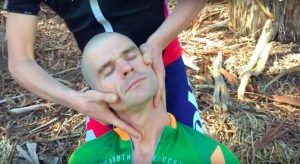Oct 20 2016
Chiropractic and Strokes
 In February Playboy model and instagram star Katie May died suddenly of a stroke at age 34. Recently TMZ obtained a copy of the coroner’s report from her autopsy which concludes that the stroke was due to a tear in one vertebral artery, which in turn was caused by neck manipulation by a chiropractor.
In February Playboy model and instagram star Katie May died suddenly of a stroke at age 34. Recently TMZ obtained a copy of the coroner’s report from her autopsy which concludes that the stroke was due to a tear in one vertebral artery, which in turn was caused by neck manipulation by a chiropractor.
This is a good time to review the evidence surrounding the issue of chiropractic manipulation and strokes, which is a concern expressed by many experts but largely denied by the chiropractic profession.
Strokes in young people (<50) are extremely rare. A stroke is caused by blockage of an artery feeding the brain leading to lack of oxygen causing injury and even death to brain cells. Arteries can be blocked if a blood clot lodges in the artery (an embolus), or if a clot forms in the artery (a thrombus).
One major cause of young strokes is trauma to one of the four arteries that feed the brain: two carotid arteries in front and two vertebral arteries in back. The trauma can cause a tear in the inner lining of the artery, which is called a dissection. That tear causes turbulence in blood flow, which in turn can result in a blood clot (when blood isn’t flowing it tends to clot). That blood clot or thrombus can block the artery if it gets big enough, or a piece can break off and lodge down stream, either way causing a stroke.
Strokes in the vertebral system are especially bad since they feed the brain stem, which is a critical structure that contains many basic functions, like breathing, and connects the brain to the rest of the body. A large stroke in the brainstem is often fatal.
So, what happened to Katie May? By reports she had a bad fall during a photo shoot and felt that she had a “pinched nerve” in her neck. She visited her chiropractor who gave her a neck manipulation. Soon after that she suffered a massive stroke.
The coroner’s report indicates that she had a traumatic tear in one of her vertebral arteries, and apparently also concludes that this tear was specifically caused by her previous chiropractic manipulation.
Chiropractors are likely to argue that the tear could have been caused by the fall itself, and that her neck pain, which she thought was a “pinched nerve” was in fact due to the tear in her vertebral artery.
This is possible, but you cannot conclude the fall caused her vertebral dissection. At best you can argue that we don’t know if it was the fall or the manipulation. We would need to know details of the fall, what kind of injury it caused, the details of her “pinched nerve” pain, and whether or not it could have plausibly been vertebral dissection pain. Apparently the coroner did not think the fall caused the dissection as they blamed it specifically on the manipulation.
Even if the fall caused the dissection, that is not much of a defense for the safety of chiropractic neck manipulation. Why did the chiropractor not recognize that he was dealing with a patient with a vertebral dissection? If the details of her pain suggested a dissection, that should have been considered and evaluated. If that were diagnosed and treated it could have avoided the later stroke (there’s no guarantee, but it’s possible).
Further, you should never manipulate the neck of someone with an active vertebral dissection. That can worsen the tear, progress the clot, or cause it to embolize and cause a stroke. Saying that the chiropractor missed the diagnosis of vertebral dissection and inappropriately manipulated her neck anyway, is not a good defense.
Chiropractic and Stroke
We have written extensively at Science-Based Medicine about the published evidence regarding a possible association between chiropractic neck manipulation and stroke due to dissection. I won’t repeat that all here, but the quick summary is this:
There is an association between the risk of stroke in young people and recent neck manipulation by a chiropractor. The evidence is not sufficient to say we have proven a causal connection, but that is due to insufficiency in the evidence. The data is mostly from retrospective chart review and single case reports where the connection seems extremely clear.
Of course, we cannot do controlled trials looking to see how many strokes are caused. That is the case with most possible risks. We look for correlations and then err on the side of caution.
It is really up to chiropractors to adequately demonstrate the safety of their intervention, especially in light of evidence suggesting a significant risk.
Further, there is no convincing evidence that there is any efficacy to chiropractic neck manipulation. So there is possible risk without clear benefit.
Put simply, if chiropractic neck manipulation were a drug, the FDA would have pulled it from the shelves based upon the current evidence (or never approved it in the first place).
This is just one more line of evidence that the chiropractic profession does not have a science-based standard of care. They appear to be more concerned about their profession than the health of their patients. Every time they crack someone’s neck they are subjecting them to risk without any evidence of benefit.






